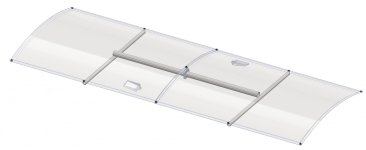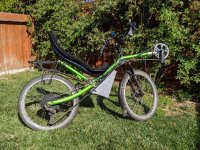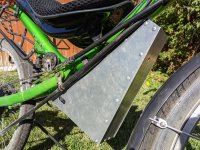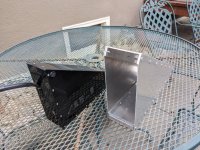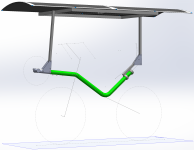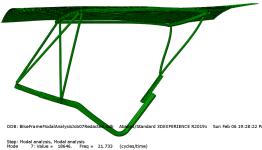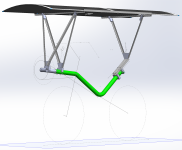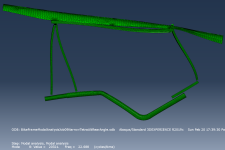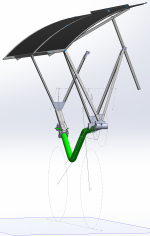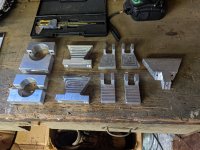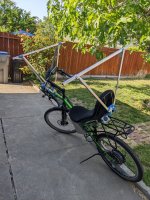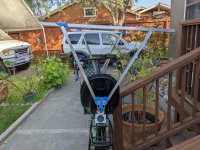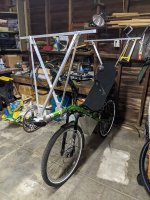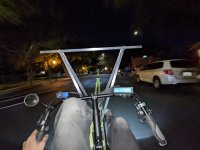Thanks for the fabrication envy! As an engineer, you clearly also have facility with CAD programs and one of my big tasks as soon as I'm done with the major fabrication on this build is to delve into Fusion 360 so I can create some better parts for things like my idler pulleys, and then either go to the maker space and learn how to machine them myself, or send out to have the parts created by a service like Send-Cut-Send. I'm not 100% certain if they are only flat-stock cutting and drilling, or if they have the ability to machine more complex parts. When I originally bought my first e-assist it was only for making a cargo bike less of a chore to ride - loaded or unloaded. Out of that grew a desire to use cargo bikes for more than just hauling and for stuff like carrying camping gear and the like. Long range batteries became my end goal, but solar recharging was also on the table, but say 5 years ago there didn't seem to be as much in the way of less expensive, viable photovoltaics that could be used on a bike. Also, it seemed like most of the ebike crowd was more concerned with recharging a battery up to full capacity, rather than bypassing a battery and running a motor directly off solar panels.
It seems now, like most of the "solar pioneers" like you, Solar e-bike and Justin at Grin (and I'm sure many others), are concentrating on how to make touring with solar a more viable way to cover greater distances due to the motor assistance extending range, but not necessarily being rigidly tied to opportunities to recharge along the way. I've seen a few e-bike touring distance records set in recent years but they're all dependent on large capacity batteries and frequent stops a convenience stores and the like where the rider is able to steal a little top-up. Seems like it's a MUCH better route to incorporate solar into the mix as it lessens that dependence on recharging infrastructure. Anyway, I guess tying in with that is that my mid-drive motor is great for the torque for hauling weight and it can be geared down for hill climbing so the motor rpms stay high which is better for cooling, but the lack of regen capability seems like it potentially limits some of the benefits of solar on the trike. Granted, Chicago and the surrounding countryside for 200 miles is flat AF, but we don't always plan on living here. Ideally we want to move to Colorado or New Mexico and both of those states would be great for solar but they also have hills and mountains.
I like how Grin did dual hub motors on their trikes and they probably benefited more output-wise in their case by sticking with 20" wheels versus the monster 26" full-fat that I've chosen. As you mentioned, 26" fat tires *can* offer a kind of crude suspension just from volume alone, but my reasoning was a few criteria. I wanted all three wheels to be 26" to allow getting on/off the trike to be easier (my wife has balance/coordination issues), and that also allowed for a higher ride height which equals better traffic visibility, and finally I'd envisioned being able to handle some light off-road riding which would be difficult without the traction and clearance of the bigger tires. Currently those tires are set up with tubes, but the plan is to switch them all out to tubeless once the trike is built and all the other kinks are worked out.
I've run tubeless on several bikes now, and the decrease in rolling resistance is well worth it, assuming you've picked decent quality tires with a supple casing. Also, the lack of needing to mess around with tire patching in case of punctures is well worth it, especially on a trike equipped with disc brakes where one not only has to remove the wheel, but must also detach the disc caliper as well. Incidentally, if I had this all to do over, I'd have done Sturmey-Archer drum brake hubs especially because you can get one that has a dynamo built in. Anyway, digression aside, tubeless = lower rolling resistance, and the particular tires I chose - Schwalbe Jumbo Jim has the lowest rolling resistance of ANY fat bike tire, and it's actually even got respectable numbers when compared with tires much smaller in volume. Don't be afraid to go "big" on your recumbent. I don't know the rolling resistance numbers on the Schwalbes you picked out, but the might even be some others that are better. Flat protection isn't always the end-all be-all, especially if you can set them up tubeless. The flat protection layer often makes the casing less supple and the tires will eat up more watts just keeping them rolling compared to more supple tires, especially if run tubeless.
If I'd have known about the Nazca close-out... *maybe?* I might have seen about picking up a frame? Probably not I think. The other reason for picking a trike design (besides cargo hauling stability and stability in tandem-mode), was stability for myself. In the last 10 years or so of car-free living and using a bike to get around almost exclusively, I've racked up a LOT of miles and with high mileage comes higher incidence of "something will happen to you eventually." Luckily I've only been hit by a car twice in 20 years, and the most recent time was a year ago in snow/ice and I was just tapped from behind by a car sliding into the intersection. Neither the bike nor I was injured. However, in those 10 years of 2-wheeled riding, I have jacked up a hip badly in a crash, a wrist, a knee, and a broken rib. All those were from crashes of just me riding along, sometimes wet pavement, sometimes icy, but all made worse by the force that hits you when you fall off a traditional up-right bike even at low speed. I almost bailed a couple times when I had my 2-wheel Bacchetta Giro 20 recumbent a few years ago and I just felt the instability, especially in low-speed riding wasn't worth the lighter weight, higher speed trade off of 2-wheel vs trike. So, trike it is for me going forwards. Also, my own engineering interests seem to lie down this whole solar/utility avenue, and that just seems to work better on three or four wheels. I'm already planning another couple trikes and velomobiles!
 ) Fancy features:
) Fancy features: